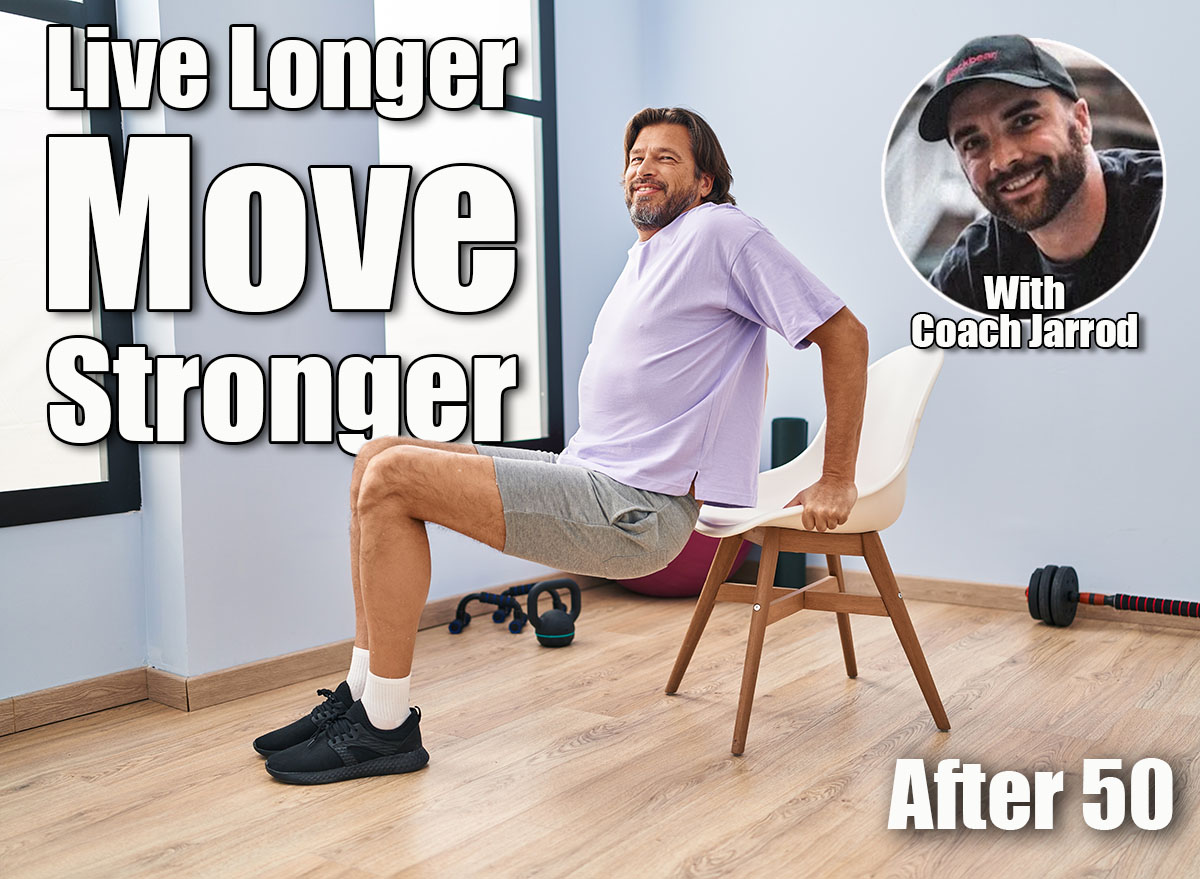5 Chair Exercises Men Over 50 Must Do To Live Longer

For men over 50, movement is medicine, and every rep you knock out makes a difference in how well you age. While barbells and dumbbells take the main stage more often than not, a simple chair can help you build strength, improve balance, and stay independent for decades to come.
Chair-based exercises are low-impact, safe, and practical. They challenge your muscles, stimulate circulation, and protect your joints without requiring fancy equipment. More importantly, they create a foundation of functional strength that carries into your everyday life. Standing up from the couch, climbing stairs, or even carrying groceries becomes easier when you practice these movements regularly.
Longevity isn’t about chasing extremes. It’s about consistency and efficiency. The following chair exercises target every major muscle group, boost circulation, and help preserve bone density. When done regularly, they can keep you strong, stable, and confident well beyond your 50s.
Below are five essential chair exercises every man over 50 should include in his routine. Each one is straightforward, effective, and will help you extend your health span.
5 Chair Exercises Men Over 50 Must Do to Live Longer
Chair Squats
Think of chair squats as your ticket to keeping independence for decades. This exercise is a direct rehearsal for one of the most essential daily moves: standing up. Every time you rise from a chair without using your hands, you’re training strength, balance, and control. Strong legs and hips reduce your fall risk, protect your joints, and keep you mobile enough to travel, play with grandkids, or simply keep doing the things you enjoy. The chair adds structure and safety, making this a potent and accessible move.
Muscles Trained: Quadriceps, hamstrings, glutes, calves, core.
How to Do It:
- Sit tall at the edge of the chair with feet flat and shoulder-width apart.
- Cross your arms in front of your chest.
- Press through your heels and stand up in a controlled motion.
- Lower your hips back down until you gently touch the chair.
- Repeat for your set.
Recommended Sets and Reps: Perform 3 sets of 12–15 reps. Rest for 45–60 seconds between sets.
Best Variations: Add a light dumbbell, hold a backpack, or perform a slow tempo squat.
Form Tip: Keep your chest lifted and knees tracking over your toes. Avoid collapsing forward.
Chair Dips
Chair dips give your arms the strength and definition that show up in real life. Strong triceps aren’t just for aesthetics; they’re vital for pushing yourself up from a seated position, getting off the floor, or pressing away from a counter. The move also challenges your shoulders and chest, reinforcing upper-body power that keeps you capable as the years go on. Plus, there’s a satisfying pump that reminds you you’ve still got it.
Muscles Trained: Triceps, shoulders, chest, core.
How to Do It:
- Sit on the edge of the chair and place your hands next to your hips.
- Walk your feet forward and slide your hips off the chair.
- Bend your elbows and lower yourself toward the ground.
- Press through your palms and return to the starting position.
- Repeat for your set.
Recommended Sets and Reps: Perform 3 sets of 8–12 reps. Rest for 60 seconds between sets.
Best Variations: For an easier version, bend your knees; for more difficulty, extend your legs straight.
Form Tip: Keep your elbows pointing backward, not flared outward.
Seated Leg Extensions
Knee pain and weakness don’t have to come with the territory of aging. Seated leg extensions strengthen your quadriceps, which act like shock absorbers for your knees. Strong quads protect joint health, improve your ability to walk long distances, and keep you climbing stairs without hesitation. This move is joint-friendly, simple to perform, and an effective way to keep your legs strong without strain.
Muscles Trained: Quadriceps, hip flexors.
How to Do It:
- Sit upright with your back against the chair.
- Place both feet flat on the floor.
- Extend one leg until it is straight and parallel to the ground.
- Hold for 2 seconds, then lower slowly.
- Alternate legs until the set is complete.
Recommended Sets and Reps: Perform 3 sets of 10–12 reps per leg. Rest 30–45 seconds between sets.
Best Variations: Add ankle weights for resistance or hold the extended leg for a longer time.
Form Tip: Squeeze your quads at the top of each rep to maximize muscle activation.
Seated Knee-to-Chest Raises
Your core isn’t just about visible abs. It’s the foundation of balance, spinal support, and posture. Seated knee-to-chest raises target your lower abdominals and hip flexors, two areas men often neglect. Strength here reduces back discomfort, keeps your gait strong, and helps you feel steady on your feet. A strong core also means you can lift, twist, and move with less risk of injury, which is a must for staying active past 50.
Muscles Trained: Lower abdominals, hip flexors, obliques.
How to Do It:
- Sit near the edge of the chair with your back straight.
- Place your hands lightly on the sides of the chair for support.
- Lift both knees toward your chest in a controlled motion.
- Lower your feet back to the ground without slamming them down.
- Repeat for your set.
Recommended Sets and Reps: Perform 3 sets of 12–15 reps. Rest for 45 seconds between sets.
Best Variations: For beginners, perform one leg at a time, or extend your legs outward for an added challenge.
Form Tip: Keep your core engaged and avoid leaning back too far.
Seated Overhead Press with Chair Support
Shoulder strength makes life easier. From lifting groceries to putting luggage in an overhead bin, your shoulders take on more work than you realize. The seated overhead press builds muscular endurance in your deltoids and triceps while reinforcing posture. Training your shoulders this way helps preserve mobility and reduces stiffness that can creep in with age. The best part? You don’t need heavy dumbbells. Even light weights or resistance bands deliver benefits that protect your independence.
Muscles Trained: Shoulders, triceps, upper chest, core.
How to Do It:
- Sit tall with your back against the chair.
- Hold light dumbbells or water bottles at shoulder height.
- Press both arms straight overhead.
- Lower slowly back to the starting position.
- Repeat for your set.
Recommended Sets and Reps: Perform 3 sets of 10–12 reps. Rest for 60 seconds between sets.
Best Variations: Use resistance bands for a joint-friendly option.
Form Tip: Keep your core tight and avoid arching your lower back.
Best Tips for Getting the Most Out of Chair Workouts After 50

You can do these exercises, but doing them correctly makes the difference between going through the motions and truly getting stronger. The following tips will help you maximize your results, avoid setbacks, and stay consistent.
- Set a Routine: Perform these exercises 3–4 times per week. Consistency is the key to building strength and resilience.
- Focus on Control: Slow, controlled repetitions build muscle more effectively than rushed movements. Quality always beats quantity.
- Add Resistance Gradually: Once bodyweight feels easy, add a backpack with books, ankle weights, or resistance bands. Progressive overload keeps you progressing.
- Prioritize Form: Proper alignment prevents injury. Use a mirror or record yourself to check your technique.
- Pair with Walking: Chair exercises build strength. Add daily walking to boost cardiovascular health and complement your training.
- Stay Patient: Progress might feel slower after 50, but steady work adds up. Celebrate each gain and keep moving forward.